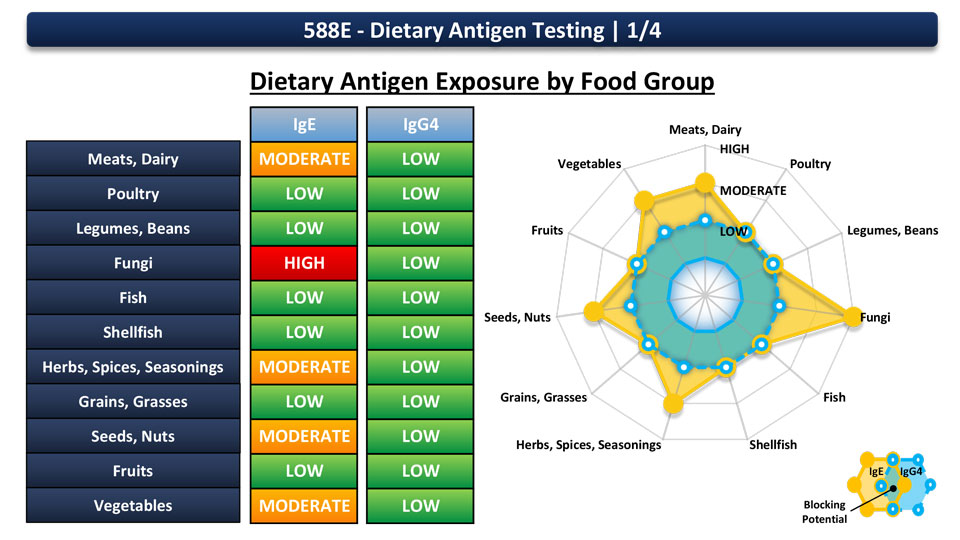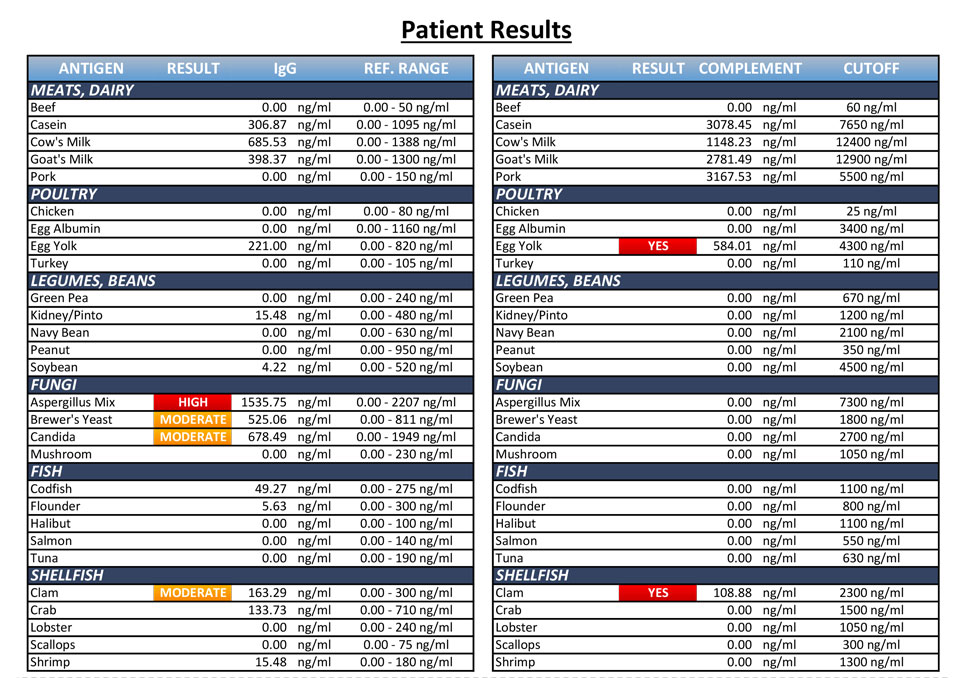Most people experience some kind of reaction to food at one time or another.
Whether it manifests as a simple bout of indigestion, a runny nose, a rash or a chronic condition like eczema, we now know that food reactions play a major role in inflammation and related disease.
Food reactions often start in infancy, and the majority of reactions in children are related to foods such as eggs, peanuts, fish and milk.
However, it is important to distinguish between true allergies and what many perceive to be allergies but are actually sensitivities or intolerances, not only to avoid an allergic reaction but also to allow appropriate treatment to be given.
Food allergy testing and food sensitivity testing are simple enough to do and may be the answer to solve many ailments, as well as make a huge difference to your general well-being.

The different types of adverse food reactions
Food reactions can basically be divided into 3 main categories:
- Allergies IgE
- Sensitivities
- Intolerances.
Food Allergy
When someone is allergic to a certain food, the immune system identifies some component of the food as dangerous, produces the antibody against it and is known as an IgE antibody response. The antibodies then bind to mast cells (located in body tissues) which will release large amounts of histamine into the body’s tissue as a result.
It is the histamine that causes the symptoms of the allergy.
IgE (Immunoglobulin E)
The IgE antibody response is the most commonly known food allergy response. This response usually occurs immediately and can create severe symptoms such as swelling, hives, itching, and – in some cases – anaphylaxis.
Even though IgE reactions are immediate, the allergic potential of food-based allergens can remain in the system 1-2 days after ingestion, extending the presence of symptoms during this duration.
IgE reactions can be permanent or they may improve with the elimination diet and gut treatment.
IgE reactions stimulate the release of Histamine in the body.
8 foods account for 95% of food allergies: soy, dairy, peanuts, tree nuts, fish, shellfish, wheat, and eggs.

Symptoms of a Food Allergy
Allergic reactions of this type usually manifest within an hour, and will affect the eyes, sinuses, airways, or skin, causing symptoms of itchy eyes, sneezing, a rash, swelling, or in severe cases, bronchial constriction. In mild cases, these symptoms will gradually subside once the offending food is removed. But in moderate to severe cases and anaphylaxis, where multiple bodily functions are affected, emergency treatment may be necessary. [1]
Food Sensitivity
The symptoms of food sensitivities are much milder than allergy symptoms and the reaction may be delayed. Again, antibodies are produced (IgG) and cause the release of histamine from mast cells to help fight the intruder. But this time, the histamine is released into the bloodstream instead of into the body’s tissues, causing less severe symptoms, which may take days to appear. However, the blood can carry the histamine to any part of the body, so symptoms can be wide and varied, making the sensitivity difficult to diagnose.
IgG (Immunoglobulin G, total)
IgG are antibodies that provide long-term resistance to infections and have a much longer half-life than the traditional IgE allergy. The IgG antibody response creates sensitivity to a particular food. Symptoms may be less severe than with IgE allergic reaction and can manifest anywhere from 3-72 hours after exposure. The delayed response makes sensitivities difficult to identify without a test.
IgG reactions create inflammation that makes many health challenges worse.
Symptoms of Food Sensitivity: consistent exposure to the offending food, and hence prolonged release of histamine, can cause trouble in the eyes, sinuses, airways and skin, but may also lead to chronic inflammation, pain, tissue damage, digestive disturbances, chronic skin conditions, and eventually disease.
These symptoms may take a few days to appear after eating the particular food.
Chronic symptoms like a constant runny nose, poor appetite, frequent headaches, mood changes, dark circles under the eyes and eczema are highly suspect of being a result of one or several food sensitivities because they don’t come on suddenly and tend to linger. [2] [3] [4]
Sensitivities can improve with treatment and improved gut health.
Food Intolerance

Food intolerances are very commonly confused with food allergies. This type of reaction, however, does not involve the immune system at all. It is caused by the inability to properly digest a food. Common intolerances are to lactose and to gluten. These occur when a person lacks the particular digestive enzyme required to digest the lactose or gluten.
Symptoms of Food Intolerance:
Food intolerances usually cause symptoms in the digestive system, such as pain, discomfort and bloating, lasting for a few hours.
If the food is discontinued, the symptoms will not recur. [3] Intolerances can improve with treatment and improved gut health.
You may be sensitive or intolerant to a food for a few reasons. These include:

- not having the right enzymes you need to digest a certain food
- reactions to food additives or preservatives like sulfites, MSG, or artificial colors
- pharmacological factors, like sensitivity to caffeine or other chemicals
- sensitivity to the sugars naturally found in certain foods like onions, broccoli, or Brussels sprouts
How can I distinguish between Food Sensitivities and Food Intolerance?

Symptoms of food sensitivity vary and create inflammation all through the body that makes many health challenges worse.
But the symptoms of intolerance are all digestive-related. These can include:
- gas and bloating
- diarrhea
- constipation
- cramping
- nausea
IgG reactions are known as delayed response reactions, those include food sensitivities, food intolerances, where IgE responses are immediate and are considered a true food allergy.
Here’s an example using Gluten . . .
Gluten-related Reactions

Gluten, the complex protein found in wheat, rye and barley, is getting a lot of bad press lately, being implicated as the cause of many gastrointestinal problems, such as bloating, diarrhoea, irritable bowel syndrome, and general pain and discomfort.[5]
The gluten-free food industry has in recent years become a multi-million dollar business, and those with an actual allergy to gluten will benefit from a gluten-free diet. However, there is some controversy as to whether people with gluten sensitivity or intolerance will benefit from this.
Reactions to gluten are varied and non-specific, making a proper diagnosis difficult without accurate blood testing. [6]
Generally speaking, gluten intolerance will cause many gastrointestinal problems such as dairrhoea, constipation, gas, bloating and even irritable bowel syndrome. A gluten intolerance is not an allergy as the immune system is not involved, and there are currently no tests for accurate diagnosis.
I have also found that Gluten can be the cause Food Sensitivities, where inflammation travels all through the body. Symptoms like trouble in the eyes, sinuses, airways and skin, but may also lead to chronic inflammation, pain, tissue damage, digestive disturbances, chronic skin conditions,
People with certain symptoms might need to be tested for celiac disease, but few people with Gluten Intolerance / Sensitivities have celiac disease. Celiac disease is an autoimmune condition, where an immune response is directed against one’s own body rather than against foreign substances as in allergies. Allergies are immune, not autoimmune, reactions.
A gluten allergy, on the other hand, is a more serious than a gluten intolerance as the immune system is involved, and will cause symptoms such as hives, shortness of breath, light headedness or vomiting. [7]
Gluten allergy testing can be done with a simple pin-prick test, during which you are exposed to the suspected allergy-causing substances and is then observed for signs of an allergic reaction.
Find Out Which Foods Are Affecting You

If you have already tried eliminating possible triggers and not seen any results, the next step is a food allergy or food intolerance / sensitivity blood test.
Removing allergenic foods based on results from our food allergy testing and food intolerance / sensitivity testing have drastically decreased food reactions in our trial subjects.
The following is an example of the test results from our lab . . .

Here at Unique Health and Wellness, we offer complete and comprehensive pin –prick blood tests which will identify multiple food allergies, sensitivities and intolerances.
Would you like to find out more?
Until next time,
Yours in Health
From the Team at Unique Health and Wellness
1] mayoclinic.org/diseases-conditions/food-allergy/symptoms-causes/syc-20355095
2] ncbi.nlm.nih.gov/pmc/articles/PMC3314037/
3] sciencebasedmedicine.org
4] britannica.com/science/food-allergy
5] journals.sagepub.com/doi/abs/10.1177/0148607111426276
6] search.proquest.com/openview/d479e15ad0ebbaa84e496a05c6834cf3/1?pq-origsite=gscholar&cbl=47659
7] onlinelibrary.wiley.com/doi/full/10.1034/j.1398-9995.1999.00081.x


MORE BLOG STORIES
Breaking Down the B Vitamins
Amazing Ways to Help Heal Mitochondrial Dysfunction!
The 5 Worst Foods For Your Gut
‘THE GOLDEN GODDESS’
Mitochondria, Inflammation and Oxidative Stress
Tired? You May Be Suffering From Mitochondrial Dysfunction